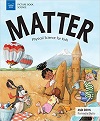|
Matter: Physical Science for Kids

Last updated Monday, April 4, 2022
Author: Andi Diehn
Illustrator: Hui Li
Date of Publication: 2018
ISBN: 1619306425
Grade Level: Kindergarten (GLCs: Click here for grade level guidelines.)
Date(s) Used: Apr. 2022
Synopsis:
What’s the matter? Everything is matter!
In Matter: Physical Science for Kids, kids ages 5 to 8 explore the definition of matter and the different states of matter, plus the stuff in our world that isn’t matter, such as sound and light. In this nonfiction picture book, children are introduced to physical science through detailed illustrations paired with a compelling narrative that uses fun language to convey familiar examples of real-world science connections. By recognizing the basic physics concept of matter and identifying the different ways matter appears in real life, kids develop a fundamental understanding of physical science and are impressed with the idea that science is a constant part of our lives and not limited to classrooms and laboratories.
| Note to readers: |
| • |
This is a good refresher on the concept of Matter.
|
| • |
Supplies that may be helpful in teaching: 1.Food scale 2. Ruler/measuring tape 3. Balloon 4. Measuring Cup
|
| Discussion topics for before reading: |
| • |
We are going to be scientists today!
|
| • |
Touch your arm.
|
| • |
Now touch something in front of you.
|
| • |
You just touched MATTER!
Vocabulary:
|
| • |
Matter----Anything that takes up space and can be weighed
|
| • |
Air----Takes up space when you put it in something. For example, a balloon.
|
| • |
Disappear----Goes away
|
| • |
Weight----Heaviness of some thing
|
| • |
Full----Holding as much as possible
|
| Discussion topics for during/after reading: |
| • |
Can you name some examples of matter using things around you?
|
| • |
Are there solids, liquids or gases?
|
| Craft ideas: |
| • |
Use these photos as you guide kids in creating their own example of different forms of matter
(clicking each link will open the image in a new browser window):
Overall craft view
Chart close-up
You can also download this worksheet PDF and share it with the kids on Zoom to encourage them to draw their own examples of these three types of matter, either on paper or using the Zoom whiteboard
|
*Note: These craft ideas are just suggestions.
You can use them, but you don't have to use them.
You can expand upon them, or add your own twist.
Remember, though, that the focus of your time should
not be on the development and execution of a craft;
the focus should be on the read-aloud and the
enjoyment of the book!
|
